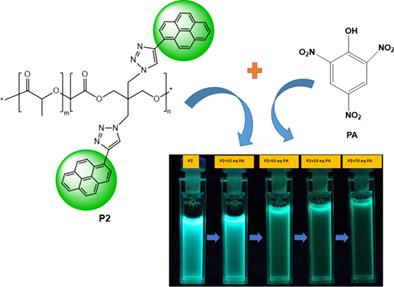当前位置:
X-MOL 学术
›
Polym. Int.
›
论文详情
Our official English website, www.x-mol.net, welcomes your feedback! (Note: you will need to create a separate account there.)
Synthesis, characterization and chemical sensor applications of pyrene side‐functional polylactide copolymers
Polymer International ( IF 3.2 ) Pub Date : 2020-09-05 , DOI: 10.1002/pi.6116 Erdinc Doganci 1
Polymer International ( IF 3.2 ) Pub Date : 2020-09-05 , DOI: 10.1002/pi.6116 Erdinc Doganci 1
Affiliation

|
A novel polylactide (PLA) polymer containing pyrene side groups (P2) was synthesized and employed as a nitroaromatic compound (NAC) and heavy metal ion (HMI) sensing chemical probe. P2 was prepared in a four‐step reaction sequence, including azidification, esterification, ring opening polymerization and click reactions. First, an azido functional cyclic carbonate monomer (ADTC) was synthesized and then a copolymer of l‐lactide and ADTC monomers was synthesized to obtain PLA with azido functional groups (P(LA‐co‐ADTC), P1). Finally, P1 was modified with pyrene groups using ‘click chemistry’ which is a highly effective modification method (P2). The chemical structures and molecular characteristics of the obtained polymers were clearly verified via Fourier transform infrared spectroscopy, gel permeation chromatography and 1H NMR analysis techniques and the fluorescence properties were examined via UV–visible and fluorescence spectrometry. The prepared P2 polymers were employed as a fluorescent probe towards certain HMI (Zn2+, Hg2+, Mn2+, Pb2+, Cd2+, Co2+) compounds and NACs (1,2‐dinitrobenzene, 2,4‐dinitrotoluene, 2,4,6‐trinitrophenol (picric acid, PA), 4‐nitrophenol (4‐NP), 2,4‐dinitrophenol (2,4‐DNP), 2,4,6‐trinitrotoluene, 4‐nitrotoluene). The fluorescence intensity of the P2 polymers was gradually reduced upon the addition of NACs and HMIs. For all compounds, the highest quenching efficiencies were attained in the presence of PA (94.03%), 4‐NP (91.11%) and 2,4‐DNP (89.08%). Because of its simplicity and sensitivity, the proposed P2 polymers can be especially considered as potential chemical probes to detect NACs. © 2020 Society of Industrial Chemistry
中文翻译:

side侧官能聚丙交酯共聚物的合成,表征及化学传感器应用
合成了一种新型的含pyr侧基(P2)的聚乳酸(PLA)聚合物,并将其用作硝基芳族化合物(NAC)和重金属离子(HMI)传感化学探针。P2按四步反应顺序制备,包括叠氮化,酯化,开环聚合和点击反应。首先,先合成叠氮基官能团环状碳酸酯单体(ADTC),然后合成l-丙交酯和ADTC单体的共聚物,以获得具有叠氮基官能团(P(LA- co- ADTC),P1)的PLA 。最后,使用“点击化学”对pyr进行P1修饰,这是一种高效的修饰方法(P2)。通过傅立叶变换红外光谱,凝胶渗透色谱和1 H NMR分析技术清楚地验证了所得聚合物的化学结构和分子特性,并通过紫外可见和荧光光谱检查了荧光性质。将制备的P2聚合物用作针对某些HMI(Zn 2 +,Hg 2 +,Mn 2 +,Pb 2 +,Cd 2 +,Co 2+)化合物和NAC(1,2-二硝基苯,2,4-二硝基甲苯,2,4,6-三硝基苯酚(苦味酸,PA),4-硝基苯酚(4-NP),2,4-二硝基苯酚(2,4- DNP),2,4,6-三硝基甲苯,4-硝基甲苯)。加入NAC和HMI后,P2聚合物的荧光强度逐渐降低。对于所有化合物,在存在PA(94.03%),4-NP(91.11%)和2,4-DNP(89.08%)的情况下,可获得最高的猝灭效率。由于其简单性和敏感性,建议的P2聚合物尤其可被视为检测NAC的潜在化学探针。©2020工业化学学会
更新日期:2020-09-05
中文翻译:

side侧官能聚丙交酯共聚物的合成,表征及化学传感器应用
合成了一种新型的含pyr侧基(P2)的聚乳酸(PLA)聚合物,并将其用作硝基芳族化合物(NAC)和重金属离子(HMI)传感化学探针。P2按四步反应顺序制备,包括叠氮化,酯化,开环聚合和点击反应。首先,先合成叠氮基官能团环状碳酸酯单体(ADTC),然后合成l-丙交酯和ADTC单体的共聚物,以获得具有叠氮基官能团(P(LA- co- ADTC),P1)的PLA 。最后,使用“点击化学”对pyr进行P1修饰,这是一种高效的修饰方法(P2)。通过傅立叶变换红外光谱,凝胶渗透色谱和1 H NMR分析技术清楚地验证了所得聚合物的化学结构和分子特性,并通过紫外可见和荧光光谱检查了荧光性质。将制备的P2聚合物用作针对某些HMI(Zn 2 +,Hg 2 +,Mn 2 +,Pb 2 +,Cd 2 +,Co 2+)化合物和NAC(1,2-二硝基苯,2,4-二硝基甲苯,2,4,6-三硝基苯酚(苦味酸,PA),4-硝基苯酚(4-NP),2,4-二硝基苯酚(2,4- DNP),2,4,6-三硝基甲苯,4-硝基甲苯)。加入NAC和HMI后,P2聚合物的荧光强度逐渐降低。对于所有化合物,在存在PA(94.03%),4-NP(91.11%)和2,4-DNP(89.08%)的情况下,可获得最高的猝灭效率。由于其简单性和敏感性,建议的P2聚合物尤其可被视为检测NAC的潜在化学探针。©2020工业化学学会



























 京公网安备 11010802027423号
京公网安备 11010802027423号